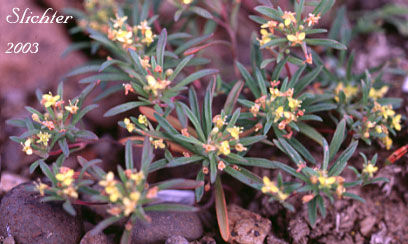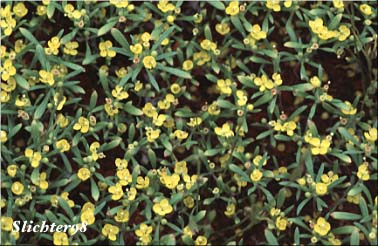Obscure evening primrose is a small, slender annual wildflower. Its leaves are alternate, linear to linear-spatulate in shape, and 5 to 25 mm long and 0.5 to 2 mm wide. The leaves are found on the upper half of the stem with the flowers clustered above the leaves. The stems are sometimes simple, but more commonly branched, the side-branches again found on the upper half of the slender stem. The herbage of stems and leaves varies from glabrous to covered with minute, straight, stiff and closely appressed hairs.
The inflorescence is congested and leafy. The minute flowers are sessile and adapted for self-pollination. The yellow flowers are crowded into short, linear-bracteate spikes. The floral tube is 0.8-2 mm long. The sepals are separately reflexed and range from 0.8-2.5 mm long. Each of the 4 individual petals are ovate and 1- 2 mm long. The 8 stamens are arranged so that there 4 longer ones with 4 shorter stamens. The style is exserted 0.7-2 mm from the floral tube. The sessile capsule is widest near its base and tapers to the tip. It is roughly quadrangular in cross-section and measures from 6-11 mm long.
The similar Hilgard's suncup (Camissonia hilgardii) has larger petals measuring from 2-4.5 mm long.
Obscure evening primrose is found in clay soils in dry fields and sagebrush scabland in the lowlands and foothills. It is frequently found in swales or shallow depressions in the soil where water collects early in the season.
Obscure evening primrose is found from southern British Columbia south along the east slope of the Cascade Mts. to California, and eastward to Wyoming and Utah.

